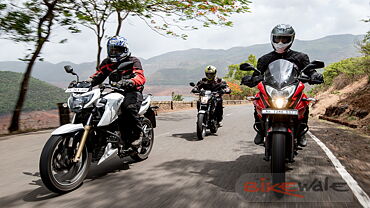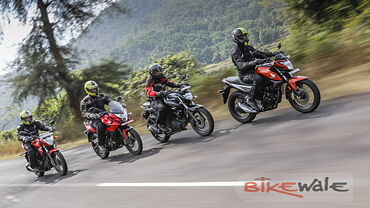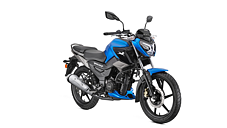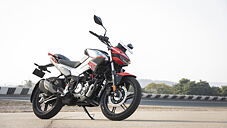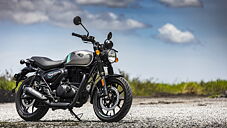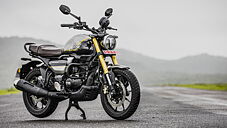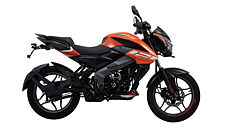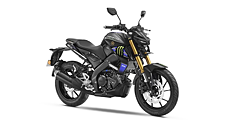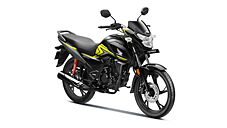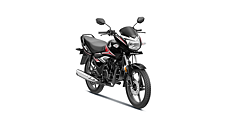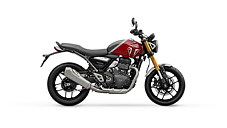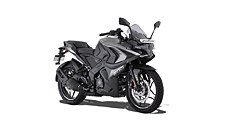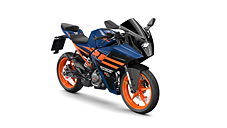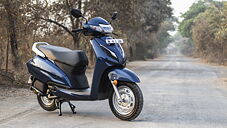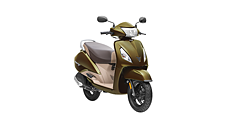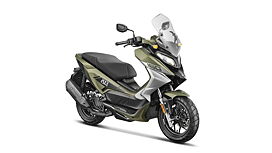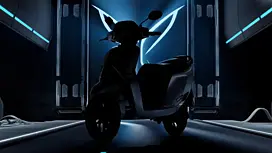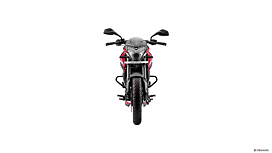Introduction

The 150cc segment today is undergoing change. Customers want more than just a big commuter machine; they want features, they want better looks, and they want to be noticed. We have two of the most sought-after premium 150cc machines – which are 160cc machines - the Honda CB Hornet 160R versus the Bajaj Pulsar NS160, a new entrant to the segment. How do they stack up against each other?
Looks

The CB Hornet 160R is an evolution of the CB Unicorn 160, but there is hardly anything in common between the two other than the headlamp and front fork design. The Hornet has a big muscular tank that is really very wide as well. It has split spoke alloy wheels, petal disc brakes, and the rear tyre is also very wide. Everything about this bike is very muscular; the mirrors, the switchgear and the diameter of the front forks feel a little ordinary compared to the rest of the design. The Pulsar, on the other hand, feels more cohesive in design. It has a more international feel thanks to the perimeter frame and the split seat, and the monoshock shows off a little more air under the rear subframe. The wheel design is also fresher than the Hornet's. The Hornet's rear tyre is wider and emphasizes it; this, we know, will matter to a lot of customers. Overall, the Pulsar is the more complete design, but the Hornet still makes a very strong case for itself especially with the snazzy graphics you see in these images.
Instrumentation, Riding Position

The Hornet derives its all-digital instrument cluster again from the Unicorn 160. It displays a whole host of information. Included is a tachometer, fuel gauge and a speedometer. It also shows two trips, the odometer and a clock. You have the regular indicator lights including neutral, high beam and the turn indicator lights above the screen, but overall it is a funky but hard-to-see instrument cluster in bright daylight.

The Pulsar has a more traditional-looking instrument cluster because it has an analogue tachometer which dominates the instrument cluster in the center. Integrated within the tachometer is a digital fuel gauge on the right. To the right of the tacho is information like the speedometer, a clock, the odometer and the trip meters. On the left are the indicator lights; it also has a ‘battery low’ warning lamp and an engine oil warning light. Additionally, it also has a shift light at the top of the display so while being more traditional than the Hornet in terms of looks, it does display more information and both the shift light and the analogue tachometer make it a lot easier to know where you are in the rev range without having to actually look directly at the speedometer which is a big plus. The Hornet still does not offer a kill switch which is a big negative when you are paying more than Rs 1 lakh for a motorcycle.

Neither of these bikes has the typical sit-up-and-beg riding position of a regular commuter. They are intended to be sporty and as such, they have riding positions that put your feet under the rider’s seat and they make you lean just a little bit in front. Both the Hornet and the Pulsar approach the handlebar with slightly different designs. Where the Pulsar opts for clip-on bars, but which are raised to make it comfortable, the Hornet has a more traditional single piece unit. However the effect is the same - you feel crouched in a sporty but not uncomfortable riding position on both these bikes. The Pulsar feels a little smaller than the Hornet mostly to the width of the tank. The Hornet makes you spread your knees quite a bit so, if you are a large person the Hornet will feel a lot more substantial but if you don't have a height advantage, the Pulsar will feel better. Whatever your size, the Pulsar feels better in traffic because of the feeling of less width that it imparts to the rider whereas the Hornet gives the impression of more stability while sport riding in corners because it offers the rider the ability to hook onto the tank with his knee very easily.

The pillion rider will be a little more comfortable on the Hornet thanks to its pillion seat which is part of a single seat and is longer and wider than the Pulsar’s split seat. Both bikes offer a split grab rail which means that the pillion rider does have something substantial to grab onto, and using a bungee cord to hook luggage on the back is simplified.
Performance and Handling

Both bikes use very similar drivelines. The Hornet uses a 163cc motor which generates about 15.04bhp and 14.7 Nm. The Pulsar, on the other hand, uses a 160cc oil-cooled motor that generates 15.3bhp and 14.6Nm. Both run on carburettion, but the Pulsar has two spark plugs and four valves, both of which are twice as many as the Honda’s. Both run their power through 5-speed gearboxes via a chain to the rear wheel. The Pulsar has a perimeter frame, but the Honda offers a rear disc brake and the 'CBS' combined braking system. Both bikes are quite eager to get off the line but the Honda’s torque is more evenly spread out over the rev range. It gets to the top of each of its gears quite quickly and always feels like a 6th gear would have been a good addition. It is also surprisingly eager to play when the road gets twisty; that fat 140mm rear tyre in no way detracts from its willingness to tip into a corner. The braking system feels a little odd because a single piston in the front calliper also actuates when you engage the rear brake, but once you spend a few days riding the Hornet you do get used to it. The Pulsar’s engine doesn't generate a lot of torque down low but get to the midrange and things perk up considerably. It also likes to go all the way to the red line which makes it a fun highway bike. Both motorcycles top out at roughly the same speed but from the midrange onwards, the Pulsar shows the Hornet a clean pair of heels. At every roll-on drag, the Pulsar overcomes its bottom-end torque deficit and pulls away from the midrange onward. The Hornet maxes out at around an indicated 110kmph whereas the Pulsar shows signs of slowing down only post 115kmph.

The perimeter frame of the Bajaj is a little bit of overkill for a 150cc machine but the benefits are felt in corners. The Pulsar never feels unsettled, no matter how hard you push it, but we wish it had slightly more grippy tyres to match the chassis performance. The lack of a rear disc brake is something we do miss but the drum brake is adequate. Despite the size difference both bikes’ kerb weights are surprisingly similar at 142kg for the Bajaj and 140kg for the Honda. At slow speeds the Pulsar feels more manageable because of more steering lock, and the lack of width makes the seat height feel low. This is a tough one because the Pulsar feels more maneuverable in the city and is quicker out on the highway but the Hornet feels like a more rounded machine and will be unruffled no matter the situation.
Verdict

The Hornet does a lot of things right – it offers CBS, feels like a bigger motorcycle than it actually is, it is surprisingly fun, it looks great and it has a rear tyre that is as wide as some almost-400cc motorcycles. However, the Pulsar offers more features and technology for significantly less money than the Honda. On sheer value, then, the Pulsar has the vote.
Images: Kaustubh Gandhi
Final scores
| Parameters | Max Points | Bajaj Pulsar NS160 | Honda CB Hornet 160R |
|---|---|---|---|
| Rank | 1 | 2 | |
| Looks & styling | 10 | 7 | 8 |
| Ergonomics & Quality | 10 | 8 | 8 |
| Features & Tech | 10 | 5 | 4 |
| Engine & Gearbox | 10 | 6 | 6 |
| Performance | 10 | 6.5 | 6 |
| Ride Quality | 10 | 7 | 7 |
| Handling & Braking | 10 | 7 | 7 |
| Fuel Efficiency | 10 | 7 | 7 |
| Price & Warranty | 10 | 6.5 | 6 |
| Desirablility | 10 | 4 | 4 |
| Total | 100 | 64 | 63 |
Specifications
| Make | Bajaj | Honda |
|---|---|---|
| Model | Pulsar NS160 | CB Hornet 160R |
| POWER TRAIN | ||
| Engine Type | Oil cooled | Air cooled |
| Capacity | 160.3cc | 162.7cc |
| Max Power7 | 15.3bhp | 15.04bhp |
| Max Torque | 14.6Nm | 14.7Nm |
| Gearbox | 5 speed | 5 speed |
| Clutch | Wet, multiplate | Wet, multiplate |
| CYCLE PARTS | ||
| Chassis | Perimeter frame | Diamond type |
| Supension F | Telescopic | Telescopic |
| Suspension R | Monoshock | Monoshock |
| Brakes F | 240mm disc | 276mm petal disc |
| Brakes R | 130mm drum | 220mm petal disc with CBS |
| Tyre F | 80/100-17 46P Tubeless | 100/80-17 Tubeless |
| Tyre R | 110/80-17 57P Tubeless | 140/70-17 Tubeless |
| MEASURES | ||
| Fuel Tank | 12 litres | 12 litres |
| LxWxH | 2012mm x 804mm x 1060mm | 2041mm x 783mm x 1067mm |
| Wheelbase | 1363mm | 1346mm |
| Kerb Weight | 142kg | 140kg (CBS) |
| COST | ||
| Price (on-road, Mumbai) | Rs 95,000 | Rs 1,03,000 |
| Warranty | 2 years | 2 years |
Gallery
1/110
Honda CB Hornet 160R Action
Double Tap to Zoom











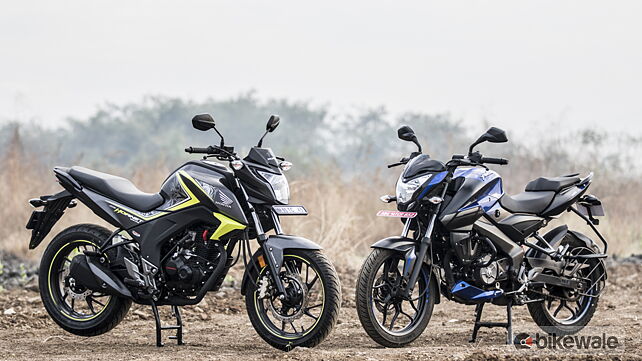







![[object Object] ThumbNail Images [object Object] ThumbNail Images](https://imgd.aeplcdn.com/642x361/bw/ec/32803/Honda-CB-Hornet-160R-Front-threequarter-117310.jpg?wm=2&q=80)
![[object Object] ThumbNail Images [object Object] ThumbNail Images](https://imgd.aeplcdn.com/642x361/bw/ec/32803/Honda-CB-Hornet-160R-Side-117311.jpg?wm=2&q=80)
![[object Object] ThumbNail Images [object Object] ThumbNail Images](https://imgd.aeplcdn.com/642x361/bw/ec/32803/Honda-CB-Hornet-160R-Rear-threequarter-117312.jpg?wm=2&q=80)
![[object Object] ThumbNail Images [object Object] ThumbNail Images](https://imgd.aeplcdn.com/642x361/bw/ec/32803/Honda-CB-Hornet-160R-Rear-threequarter-117313.jpg?wm=2&q=80)
![[object Object] ThumbNail Images [object Object] ThumbNail Images](https://imgd.aeplcdn.com/642x361/bw/ec/32803/Honda-CB-Hornet-160R-Front-threequarter-117316.jpg?wm=2&q=80)

